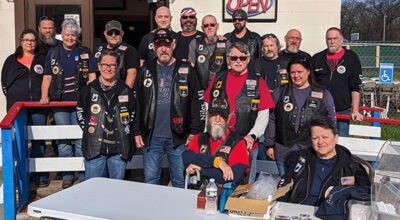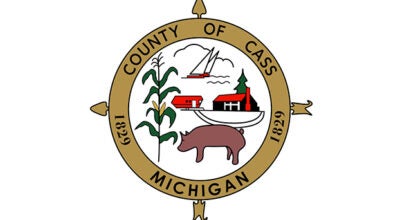Three Twin Cities companies built World War II warships
Published 9:05 am Thursday, September 3, 2009

Paul Pipik at SMC museum Sept. 2
By JOHN EBY
Dowagiac Daily News
Though “yacht yards” in the larger scheme of things, the Twin Cities’ three ship-building companies contributed 153 vessels to the World War II effort.
Boat-building flourished in St. Joseph and Benton Harbor on the Lake Michigan shoreline in Berrien County for more than a century – from the late 1820s until about 1950.
“Literally hundreds of watercraft, ranging in size from rowboats to large steamers and freighters, were built in yards along the St. Joseph River and the Benton Harbor ship canal,” Paul Pipik said. “In my view, the most dynamic and interesting period occurred between 1940 and ’45, when the yards were mobilized to construct military vessels for the (World War II) effort.
“For all practical purposes,” Pipik continued, “the rush to build ships was also a rush to the end – a bright flash before a light that had burned steadily in the Twin Cities for more than 100 years went out forever.”
Pipik, an Upton Fellow at The Heritage Museum and Cultural Center in St. Joseph, led off The Museum at Southwestern Michigan College fall lecture series Wednesday evening.
A glut of vessels produced during World War I dented demand, then “the Great Depression virtually killed international trade, which was then, as it is now, largely carried out by ocean shipping. Many nations adopted protectionist trade policies to stimulate their economies. Single-digit ship-launch volumes were the norm between the wars,” Pipik said. “This began to change in the late 1930s as it became ever more clear that the world was again heading toward a global conflict. Under the control of their ultra-nationalist leaders, Germany and Japan had both embarked on campaigns to build empires by force. They were already engaged in open war with many of their neighbors.”
President Roosevelt had been Assistant Secretary of the Navy during World War I and was “well aware that America’s sea forces were not prepared for war.”
In 1939, FDR ordered the Navy and the Maritime Commission to modernize and expand shipbuilding facilities and to design ships capable of winning at modern sea warfare.
“His decision could hardly have been more timely,” Pipik said. “Less than two years later, American sea power and its shipbuilding industry would be put to their most severe test. Roosevelt knew Americans did not want their country involved in another European war, but however desperately it was desired by American isolationists, in 1940 it was clear that the conflict would soon involve the United States.”
Japan and Germany grew more threatening, forming an alliance that September.
Germany, intent on starving Britain out of the war, dispatched submarine forces to the Atlantic coast and attacked commercial vessels within plain view of the shore.
Americans “became accustomed to beaches littered with bodies and debris,” Pipik said. Roosevelt “was just as intent on assuring Britain’s survival. In 1940, the Navy began escorting merchant shipping with guns loaded. In what was euphemistically called ‘Operation Short of War,’ American ships were soon attacking and being attacked by the U-boat fleet. We see from the hole in the side of the destroyer Monson (pictured in Reykjavik, Iceland), torpedoed in October of 1941, the United States was engaged in open war with German sea forces long before Pearl Harbor. Mounting losses made clear that America needed ships in a hurry. Orders began pouring out of the War Department for every type of vessel. As we know now, the response from American shipbuilders was beyond stunning. A nation that had produced only 817 large merchant vessels in the 20 years between the wars launched over 5,000 in the five years of World War II. Warships, which had launched at a rate of 16 a year, flew off 26 per month.”
Pipik said these “amazing results were achieved through an unprecedented concentration of authority in the Commerce Department’s Maritime Commission and the Navy’s Bureau of Ships. These organizations were given virtually total power to design and fabricate ships, participate in industrial planning for key commodities such as steel and commission the modernization and construction of shipyards, negotiate labor rates, supervise ship construction and determine what shipbuilders would be paid for their product. The vast majority of this effort was expanded in the Atlantic and Pacific coast regions. These areas had well-established yards, were close to the centers of steel production and near the battlefields. The Gulf and the Great Lakes presented special problems that resulted in less government investment and a generally lower priority from the big ship agencies.”
Pipik noted the Great Lakes proved particularly “vexing” to the government because “many of the nation’s most active and advanced shipyards were there, but could not be employed for big ships because this was before the Saint Lawrence Seaway. Ship construction in the big yards of Lorain (Ohio), Sturgeon Bay, Manitowoc (Wis.) and Bay City were restricted to smaller warships like escort destroyers, submarines and flat-bottomed landing crafts, such as LSTs. Managers and workers in these operations often found themselves sent to coastal yards where their experience could be used.”
Nonetheless, “Desperate government ship buyers sought to use every resource to the maximum – and the Great Lakes region was rich with small ship and boat yards sometimes disparagingly described as ‘yacht yards.’ These operations were generally restricted to building with wood,” Pipik related, “and depended more on the skills of the 19th century shipwright than the 20th century know-how of the engineer.”
While yacht yards weren’t the most sophisticated shops around, neither did they require huge capital investments or compete for scarce resources, such as machinery and steel plate.
Given enough manpower, they were capable of high-quality output on tight schedules.
Realizing the need for literally thousands of boats of every description, these small ships were immediately commissioned to turn out utility boats, tugs and landing craft.
“Three of the best of these yards were in the Twin Cities,” Pipik said. “What they lacked in sophistication, they made up for in flexibility, speed and quality. While the big coastal yards excelled at putting together standardized designs, the Twin Cities yards were equally adept at the rapid transition from one type to another, sometimes filling up to three unrelated designs at one time and setting production records in the process.”
Boat building began in the Twin Cities “the day the first settlers arrived,” he said. “Like the Potawatomi before them, people here came by water, lived near the water, traveled by water and generally relied on the river and the lake for their livelihoods. Good boats were an absolute necessity. Taking advantage of the timber resources, a community of skilled shipbuilders quickly grew up along the river. They were informal, relying on hand tools, a good eye and experience.”
As evident from an 1886 photo, “Yards were simple affairs that did not rely on the metal-hull technology that was taking hold in the big East Coast shipyards at the time,” he said.
Truscott Boat and Dock Co., Dachel-Carter Shipbuilding Corp. and the Robinson Marine Construction Co. were the Big Three of Twin Cities shipbuilding. Each possessed its own “personality.”
Truscott, still a revered name, was formed by Thomas and three sons and settled in St. Joseph about 1890. Three years later it became famous for supplying electric-powered launches to the Columbian Exposition in Chicago. By 1900, Truscott had an international reputation and sales outlets in Europe, Asia and South America. As a family-owned business where the old world met the new, all its products were built to demanding standards with craftsmanship and an all-under-one-room philosophy of vertical integration. It even made its own engines. Its plant made every part for every boat from scratch in its own foundry, a lumber mill, a machine shop, even a fabric shop.
In its best years, when it was St. Joe’s top employer with 700 workers, it had trouble meeting demand for its elegant products. By 1940, those years were well in the past. Boat production which peaked just before World War I slowed dramatically by the 1920s.
During the Depression, “Things got so bad,” according to Pipik, “that the 1932 St. Joseph business directory lists Truscott not as a boat builder, but as a manufacturer of automobile trailers. I n 1940, James Truscott, the last of the three brothers, sold the company to a Chicago investor who hoped to reinvigorate production with war work and a new line of pleasure boats when the conflict ended.”
Pipik said Dachel-Carter was “an altogether different kind of firm” which set up shop in 1915 in a converted lumberyard on the north side of the Benton Harbor ship canal.
Dachel-Carter specialized in larger commercial craft built to customer specifications, although “they were also known to build the occasional yacht, sailboat or speedy runabout. Dachel-Carter’s fishing boats, harbor tugs, Coast Guard patrol boats and other working ships of substantial size were sturdily built of Michigan woods using practical methods passed on from one shipwright to the next for 100 years or more. It was not until 1940 they actually had a sign that said ‘Engineering Department.’ Unlike Truscott, which built everything, the company purchased most of its specialized components from other suppliers. More of a craft shop than a factory, employment varied widely with the quantity and type of vessel on the order books. The company prospered until it, too, was virtually shut down by the Depression. Chicago investors who came shopping in 1940 found the firm down to only three employees and generally without any steady work. The best records available suggest the company built no complete vessels between 1933 and 1940.”
Robinson Marine Construction Co., the youngest of the trio, was created by Glenn Robinson, former Dachel-Carter treasurer. He broke off in 1926 to form his own concern. Son of a lake captain, he opened on the canal, but soon constructed a larger shop on the northeast corner of industrial island in St. Joseph.
A dynamic salesman, Robinson soon developed solid orders for a mix of recreational and working craft, including mail boats, tugs, ferries and Coast Guard patrol boats, though he specialized in yachts, including a line of all-mahogany speedboats called Seagulls.
“Designed for Robinson by some of the biggest names in the business, these big, stylish and powerful yachts were examples of conspicuous consumption for wealthy boat enthusiasts of the Roaring Twenties,” Pipik put it. “They remain highly prized by collectors to this day. Like his competitors, his business took a big hit in the 1930s, but was overall in better shape. Down to only six employees at the beginning of the war, the Robinson yard managed to remain locally owned throughout its history.”
As government boat-buyers came calling in 1941, he said, “We find all three of the Twin City yards idle, virtually closed and starving for business. Waking up from near-death isn’t easy, even with the prodding of government contracts and loans for capital expansion. Both Dachel-Carter and Truscott took a long while to get going. They had a lot of work to do before they could start building ships.”
Dachel-Carter erected new buildings between 1940 and 1943.
Truscott “underwent an even more dramatic transformation, displacing local fishermen to build what amounted to an entirely new plant on the northwest corner of industrial island,” Pipik said. “Unlike Dachel-Carter, however, the company did not start war production until its yard was complete in 1943. Robinson, the least dead of the three, built primarily smaller craft and was able to swing into production much faster.”
Finding workers proved a challenge. Dachel-Carter, because it built bigger vessels, offered higher wages and rebuilt its workforce to 45, 220 and, finally, more than 600 at its 1944 peak.
Truscott never exceeded 225, though it was the only yard which hired and trained large numbers of women.
Robinson also employed about 200 during the war. Retirees rejoined the ranks.
“Traditional naval ceremony” launched every ship built.
A lady in a hat and white gloves broke a bottle of champagne on the bow to christen the vessel, a clergyman prayed and a representative of the Chicago Bureau of Ships attended the ceremony presided over by an admiral doling out efficiency medals and other awards to workers.
“Each one of these launchings was a very big deal,” said Pipik, a Cleveland native whose father was a doctor. “These cities were in the war every bit as any of the big yards you hear about on the California coast or on the East Coast. Anything they could get through the Welland Canal, they built on the Great Lakes because they had really excellent yards all around the Great Lakes at that time. Yards could build metal-hulled boats. Manitowoc built over 50 submarines, which were brought down to Chicago and put on what amounted to a large pontoon and floated through the locks to the ship canal and down to the Kankakee and sailed down the Mississippi (River) from there.”
Welland Canal connects Lake Ontario and Lake Erie through a series of eight Niagara Falls-skirting locks.
Then, 50 years ago in 1959, the Saint Lawrence Seaway opened.
“The Welland Canal could only accept a ship of 236 feet,” Pipik said.
Asked if his research would be published, Pipik said, “I graduated in July (from Western Michigan University). “There’s a book in there somewhere. I’m not sure if I’m the guy to write it. When Truscott went out of business, literally everything the company owned since its original days in 1890 literally went into the trash. We have little left to rely on … Many of the harbor tugs in Chicago came out of this area, which has a long history of high-quality ships. Their big limit was they were never able to bend metal, so when wooden ships went away, they didn’t have the capital resources” to adapt.
“Great Lakes shipbuilding all started with wood,” he said. “The Ohio yards in Lorain, Cleveland and Toledo, the Wisconsin yards and, to a certain degree, the Detroit and Bay City yards, migrated to metal, but western Michigan yards never did. All the yards up and down the western shore of Lake Michigan pretty much stayed with wood construction until the business went away. After the war, there just wasn’t any demand for large wood-hulled vessels. The cost of timber had gotten to the point where it just wasn’t economical to build them, and they clearly weren’t as durable as steel ships.”
Pipik remembers a Saint Lawrence Seaway flotilla sailing to every Great Lakes port along the way, staging mock amphibious landings.
The Working Waterfronts exhibit opened in March at The Heritage Museum and Cultural Center in St. Joseph (with one of the few remaining Truscott boats, a 16-footer made in 1897 with craftsmanship “that I could sit and look at for hours,” said Tom Caskey of the SMC museum).
Pipik said on Sept. 20 near the Benton Harbor airport there will also be a large Civil War re-enactment.
“Quite a bit of black powder will be expended,” he promised.
The second fall lecture Oct. 7 will tell how to restore Round Oak stoves with Bill Krohne and Mark Luthringer.






